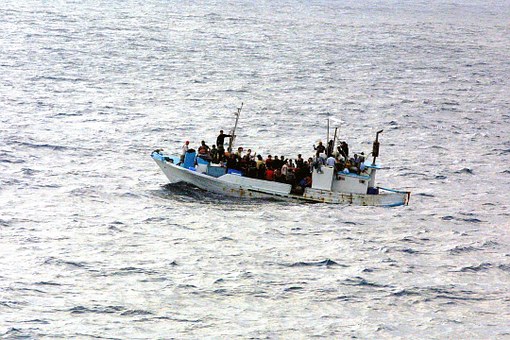Despite the global spotlight on refugees, those who flee from climate change have little protection under international law since they do not appear to face a ‘fear of persecution’ from the state. As global temperatures rise and millions flee their lands, a crisis is impending and the world needs a solution very quickly.
Last October, I remember standing among a tense pool of delegates from the Netherlands and international experts at Palais des Nations in Geneva. The news of the year was just out: The Intergovernmental Panel on Climate Change (IPCC) had just released a Special Report on global warming, describing the dangerous consequences of temperatures going up by 1.5˚C. Against this backdrop, the discussion moved towards understanding the humanitarian implications of climate change, which has produced a whopping 140 million climate refugees worldwide – nearly half of America’s entire population.
Yet, climate refugees are given limited space within the broader global discourse. This is because the Convention Relating to the Status of Refugees, 1951 (or the Refugee Convention) is essentially centered around the government. We understand refugees as an obstruction to state sovereignty and security. The Refugee Convention’s exhaustive grounds – of race, religion, nationality, membership in a particular social group and political opinion – leave behind no room for the legal recognition of climate refugees.
Additionally, the fact that climate refugees do not appear to face a ‘fear of persecution’ from the state – as mandated by the Refugee Convention – condemns them to exclusion from the Convention. The discussion progresses little beyond this reasoning and the case for legalizing climate refugees becomes a lost cause from the beginning.
The principle of complementary protection aims to extend the fundamental legal principle of not forcing refugees to return to a country where they are likely to face persecution (called ‘non-refoulement’) to grounds beyond the Refugee Convention’s. But its application is largely left to the discretion of states.
Yet, the crux of the problem is less about advocating for the Convention’s recognition of climate refugees and more about how the current global framework shapes the approach of countries in formulating their refugee laws and policies. For instance, the Pacific Island nations have been in the spotlight for extreme weather changes and rising sea levels that pose an imminent threat to the livelihoods of people. Food shortages, unemployment and the disruption of daily lives have pushed islanders from Kiribati and Tuvalu to seek refuge in New Zealand and Australia.
One such case appeared before the New Zealand Immigration and Protection Tribunal (Refer case: AF Kiribati 2013 NZIPT 800413). The Tribunal’s judgment highlights the tragedy of the current approach towards climate refugees. In refusing the application, the Tribunal held, “while the environmental conditions in Kiribati can involve significant human rights issues, the claimant must still establish that they meet the legal criteria set out in the Refugee Convention”.
It is pertinent to observe that the rights that are to be protected in this case are similar to the rights of other groups of refugees. But due to shortcomings in international refugee law, climate refugees are seen as voluntary economic migrants, rather than as people who are forcibly displaced from their lands.
In South Asia, frequent floods, droughts, earthquakes and rising sea levels have accelerated the need for countries to formulate comprehensive schemes of rehabilitation and resilience to the human impacts of climate change. In 2017, weather-related disasters affected around 40 million people in Bangladesh, Nepal and India alone.
In the Hindu Kush Himalayan (HKH) region – stretching from Pakistan to Myanmar – several settlements are in jeopardy as livelihoods get threatened. HKH has been a reservoir of natural resources and a significant source of livelihood for millions of people across the countries it embraces. In recent years, HKH has been experiencing global warming at alarming levels and this has been highlighted by the IPCC. Lack of food security (as a result of global warming) is the most pressing reason for the displacement of these populations.
While climate refugees in the region have historically moved within their own countries – trying to rebuild homes in similar environments – we can well anticipate food shortages and unemployment due to climate change to force people to move outside of their countries. Although the current refugee movements in Afghanistan, Myanmar and Bangladesh seem to have little to do with climate change, one cannot undermine environmental concerns as a trigger, or even as an independent occurrence in itself to force people to move.
India has a history of admitting refugees from these countries, but without a clear legal framework. India has not ratified the Refugee Convention and its 1967 Protocol, but has adopted the principle of non-refoulement in its approach of admitting refugees in the past. However, its policies towards refugee groups have often been in the nature of ad hoc and reactionary responses – not as a result of a clear or coherent policy framework.
In the realm of climate refugees, there is no precedence of acknowledgement by India so far. None of the relevant laws such as as the Foreigners Act, 1946, Passports Act, 1967, the Illegal Migrants (Determination by Tribunal) Act, 1983, or the controversial Citizenship Amendment Bill, 2016 that was recently shelved, reflect a complete picture on where we stand on taking in refugees.
Nonetheless, the global community’s expansion of the dialogue to environmental grounds in the Global Compact for Migration 2018 and the Global Compact on Refugees 2018 is a sign of optimism, specifically for India as it has adopted both these instruments. While neither has any legally binding force, they still provide guidance on a transnational approach that countries can adopt in pursuit of justice for those displaced from their homes.
Climate change has implications that go far beyond just changes in the weather and it is increasingly imperative to view environmental issues through the prism of other disciplines, in this case through refugee law. Adapting to climate change requires a bottom-up legal response, originating from the domestic level. The climate refugee crisis has the potential to send shockwaves across the developing world – and it needs a smart solution very quickly.
Malavika Rao is the Environment Editor of Freedom Gazette. She is currently a PhD Candidate in International Law at the Graduate Institute Geneva. She is a graduate of Environmental, Energy and Clean Technology Law from UC Berkeley.


